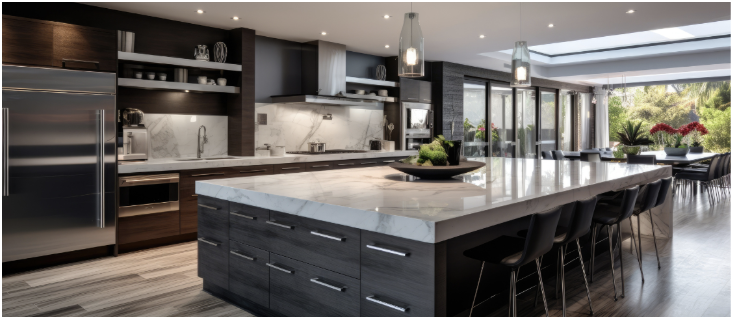
A kitchen remodel can be an exciting and transformative project for your home. Whether you're looking to update the look, improve functionality, or increase the value of your property, careful planning is essential to ensure a successful outcome. In this step-by-step guide, we'll walk you through the process of planning your Orange County kitchen remodel to help you achieve your goals efficiently and within budget.
Step 1: Define Your Goals and Budget
1.1 Determine Your Objectives
Before you start tearing down walls or choosing new appliances, take some time to define your goals. What do you want to achieve with your kitchen remodel? Common objectives include:
- Improving functionality: Are you looking to create a more efficient kitchen layout, with better storage and workspace?
- Enhancing aesthetics: Do you want to update the look and style of your kitchen to better match your tastes or current design trends?
- Increasing home value: Are you remodeling with an eye on potential resale value?
- Fixing structural issues: Does your kitchen have structural problems that need addressing?
1.2 Set a Realistic Budget
Your budget is one of the most critical aspects of your kitchen remodel. It's essential to set a realistic budget based on your financial situation and project goals. Research the average costs of kitchen remodeling in your area to get a ballpark figure. Keep in mind that unexpected expenses can arise during the project, so it's wise to allocate some extra funds for contingencies.
Step 2: Research and Inspiration
2.1 Gather Ideas
Start gathering ideas for your kitchen remodel. Browse home design magazines, visit kitchen showrooms, and explore online platforms like Pinterest and Houzz to gather inspiration. Create a vision board or folder to save images, articles, and notes that resonate with your style and goals.
2.2 Consult with Professionals
Consider consulting with kitchen designers, kitchen remodeling specialists, contractors, or architects. Oftentimes a kitchen remodeling specialist can evaluate your current set up, make recommendations and even complete the design as part of their service. They can provide valuable insights and help you refine your ideas. Professionals can also provide cost estimates based on your project scope and help you make informed decisions about what's feasible within your budget.
Step 3: Kitchen Layout and Design
3.1 Evaluate Your Current Layout
Assess your existing kitchen layout and determine what works and what doesn't. Consider factors such as traffic flow, workspace efficiency, and the placement of appliances and fixtures. Identify any structural changes that may be necessary, such as moving walls or changing the layout.
3.2 Create a Functional Layout
Work with a kitchen designer or use design software to create a functional kitchen layout. Consider the kitchen work triangle, which includes the sink, refrigerator, and stove. Aim for a layout that minimizes unnecessary movement between these key areas.
3.3 Choose Materials and Finishes
Select materials and finishes that align with your design vision and budget. This includes cabinets, countertops, backsplashes, flooring, and hardware. Keep in mind factors like durability, maintenance, and how the materials complement each other in terms of color and texture.
Step 4: Select Appliances
Choose kitchen appliances that suit your cooking habits and lifestyle. Consider factors like size, energy efficiency, and features. It's also crucial to ensure that your selected appliances fit seamlessly into your kitchen layout.
Step 5: Create a Detailed Project Plan
5.1 Timeline and Schedule
Create a detailed project timeline that outlines when each phase of the remodel will occur. Be realistic about the timeframes and consider any potential delays that may arise. Keep in mind that kitchen remodels typically take several weeks to complete.
5.2 Permits and Regulations
Check with your local government and homeowners' association to determine if permits or approvals are required for your kitchen remodel. Failure to comply with regulations can lead to costly delays and fines.
5.3 Contractor Selection
If you're hiring a contractor, conduct thorough research and obtain multiple quotes. This could very well be the most important step in the entire process; choose wisely! Check references, licenses, and insurance. Once you've selected a contractor, ensure that all project details, including timelines and payment schedules, are documented in a signed contract.
5.4 Ordering Materials
Order materials and products well in advance to avoid delays. Some items may have long lead times, so it's essential to plan accordingly.
Step 6: Prepare for Construction
6.1 Clear the Space
Before construction begins, clear your kitchen of all items. This includes appliances, dishes, cookware, and any other belongings. Protect valuable items by storing them safely away from the construction zone.
6.2 Set Up a Temporary Kitchen
During the remodel, you may be without a functional kitchen for some time. Set up a temporary kitchen in another area of your home. This can include a microwave, portable cooktop, and a space for food preparation.
Step 7: Execute the Remodel
7.1 Demolition
Demolition is typically the first step of the remodel. This involves removing old cabinets, countertops, appliances, and any other elements that need replacing. Ensure that the demolition is done carefully to avoid damaging the structural integrity of your home.
7.2 Structural Changes
If your remodel involves structural changes, such as removing walls or relocating plumbing and electrical systems, this is the phase where these alterations occur. It's essential to work with professionals to ensure these changes are done correctly and safely.
7.3 Installation
Cabinets, countertops, backsplashes, and flooring are installed during this phase. Be prepared for some disruption to your daily routine, as your kitchen will be a construction zone.
7.4 Plumbing and Electrical
Plumbing and electrical work is completed, including the installation of sinks, faucets, lighting fixtures, and appliances. Ensure that all connections are up to code and that safety measures are in place.
7.5 Finishing Touches
Once the major components are in place, it's time for finishing touches. This includes painting, trim work, and the installation of cabinet hardware and backsplash tiles.
Step 8: Inspect and Approve
Before finalizing the project, conduct a thorough inspection of the remodel to ensure that all work has been completed to your satisfaction. Address any issues or concerns with your contractor and make sure they are resolved.
Step 9: Clean Up and Move In
Once the remodel is complete and you're satisfied with the results, it's time to clean up the construction dust and debris. Give your new kitchen a thorough cleaning before moving back in. Arrange your kitchen items in an organized and functional manner.
Step 10: Enjoy Your New Kitchen
Congratulations! Your kitchen remodel is finished, and you can now enjoy the fruits of your planning and hard work. Host a dinner party or invite friends and family to see your newly transformed kitchen.
Planning a kitchen remodel can be a complex and time-consuming process, but with careful consideration and preparation, it can also be a highly rewarding one. By defining your goals, setting a realistic budget, and following this step-by-step guide, you can achieve the kitchen of your dreams while minimizing stress and unexpected setbacks. A well-planned kitchen remodel can enhance the functionality, aesthetics, and value of your home for years to come.
Subscribe to Cabinet Wholesalers's Blog









Comments